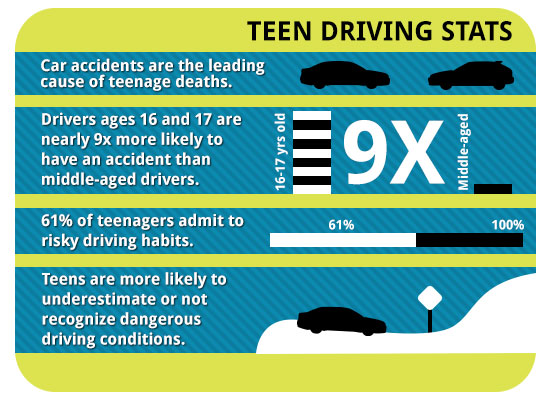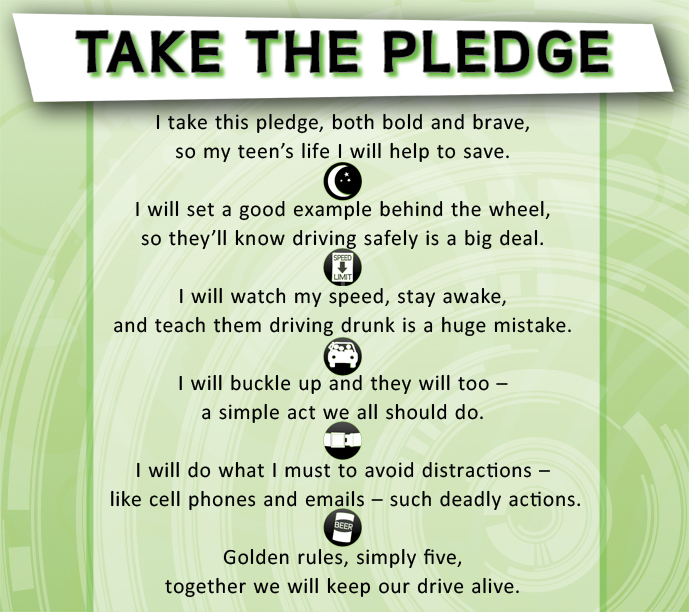Teen Driving
Auto Insurance for Teens
Having a newly teen driver in the house can be exciting but also worrisome. Teens have little driving experience and young drivers are at a greater risk for an accident. Safety is the main concern on a parent’s mind as well as other related factors – like the cost of insuring your teen driver and the financial liability of them having an accident.
Communicate with your teen about driving a car and the responsibilities that come with it, including the cost of insurance. Let your teen know about the serious consequences of having a moving violation or accident, and how it will impact increasing insurance rates. As your teen gets older, insurance rates will drop providing he/she maintains a good driving record (no tickets or accidents).
Companies offer discounts and reduction in premiums if –
• Students who maintain at least a “B” average in school.
• Teens who take a recognized driver training course.
• College students who attend school at least 100 miles away from home and do not bring their car to school.
Educate Your Teen on Driving
It is our job as a parent to educate our teen driver on the rules and laws of safe driving. Before your teen hits the road set these “5 to Drive” rules.
1. No Cell phones while driving.
2. No extra passengers.
3. No speeding.
4. No alcohol.
5. No driving or riding without a seat belt.
Why do teens have more accidents? It is due to inexperience driving. Teens drivers struggle with judging gaps in traffic, driving the right speed for conditions and turning safely among other things. Parents should continue to practice driving with their teen even after they obtain their drivers’ license. The more you continue to practice driving with your teen, the more experience they will have when they are behind the wheel, and the less likelihood of an accident.
What Can You Do as a Parent?
• Communicate to your teen the importance of driving. Before handing the keys to your teen talk to them and set some ground rules. Discuss your states rules and laws (varies by State). Know what restrictions were placed on your teens license, this will help better assist you in enforcing those laws.
• Remind your teen about the dangers of alcohol and drugs behind the wheel. Remind them it is illegal to drink under the age of 21, and deadly to drink and drive. Talk to your teen about the severe consequences and impact it can have on them, their family and maybe someone else’s family.
• It is our job as a parent to be a good role model and set the example. Remember, your child looks up to you as a driver, so practice safe driving yourself. A great way to spend some one on one quality time together with your teen is by taking him/her out for some practice driving sessions. This will help your teen improve on some basic driving skills. Your teen’s learning starts at home.
• Have your teen take drivers education class to help educate them on driving. Parents do not depend merely on the class to teach your teen to drive. Drivers education should just be used as part of the Graduated Driver Licensing (a.k.a. – GDL).
Allow Lancaster Insurance Center to help you choose a policy that will fit your individual or family’s needs. Our goal is to help you protect what matters most by protecting your assets, whether personal, business, or both. A well-chosen policy can lessen the impact of some of life’s most common, yet unforeseen perils.
Contact Lancaster Insurance Today today for a quote!

Statistics of Teen Driving
• Motor vehicles crashes are the leading cause of death and disability to teens in the United States.
• Most teen driving accidents are due to three “critical errors,” lack of scanning, speeding and distractions.
• Teen drivers are more likely to crash if impaired, using a cell phone, or have their friends in the vehicle.
• Motor vehicle accidents are higher among teens between the ages of 16-19 than any other age group.
• Most newly licensed teen drivers leave the learner’s permit period with significant skill deficits, leading to a much higher risk of accident compared to a more experienced driver. The most common types of accidents involved are – left turns, rear-end events, and running of the road.

Facts of Teen Driving
• In 2018, 37% of motor vehicle deaths among teen drivers and passengers were between the age 13-19 occurred between 9 p.m. and 6 a.m., and 52% occurred on Friday, Saturday, or Sunday.
• In 2018, 30% of male drivers between the age 15-20 and 18% of female drivers between the age 15-20 were involved in a fatal car accident due to speeding.
• In 2018, 15% of drivers between the age 16-20 were involved in a fatal car accident due to being under the influence of alcohol.
• 12% of distracted drivers involved in a fatal car accident were teens between the age 15-19.

